The Old Curiosity Club discussion
David Copperfield
>
DC, Chp. 07-09
 Mary Lou wrote: "I'm curious, Tristram - do you enjoy graphic novels? I've tried to read a few but find them visually overwhelming "
Mary Lou wrote: "I'm curious, Tristram - do you enjoy graphic novels? I've tried to read a few but find them visually overwhelming "My kids love these and I try to read them and I think it's a kind of literacy I never picked up. I can't disappear in a graphic novel like I do in a book: I have to work at it and I guess I'm lazy. Or else I just have too many other things I want to read instead.
 Julie wrote: "maybe it's uncomfortable when David makes sure Steerforth knows he's a gentleman and the Peggottys are his inferiors not because Dickens doesn't think they're David's inferiors, but because it displays David's insecurity. If David were a better or more confident person, he wouldn't find it necessary to emphasize his status as a gentleman's son..."
Julie wrote: "maybe it's uncomfortable when David makes sure Steerforth knows he's a gentleman and the Peggottys are his inferiors not because Dickens doesn't think they're David's inferiors, but because it displays David's insecurity. If David were a better or more confident person, he wouldn't find it necessary to emphasize his status as a gentleman's son..."
Julie wrote: "Tristram wrote: "While this may sound like harsh criticism, we ought to bear in mind that it is Dickens who really gives a lot of space to lower class characters - unlike, let's say, Trollope, wher..."
If people from lower classes are not so very content with their social status, the odds are high that Dickens made them rather shifty, unpleasant characters (view spoiler). As to Hard Times, which happens to be my least favourite Dickens novel but one, we must keep this question as to the presentation of low-class characters and social change in our minds because it'll be worth our while discussing it!
If people from lower classes are not so very content with their social status, the odds are high that Dickens made them rather shifty, unpleasant characters (view spoiler). As to Hard Times, which happens to be my least favourite Dickens novel but one, we must keep this question as to the presentation of low-class characters and social change in our minds because it'll be worth our while discussing it!
Mary Lou wrote: "Tristram wrote: "This is maybe one of the reasons why I adore Phiz - his richness in detail and in life. I mean, Dickens's books abound in characters and in details, and Phiz is one illustrator to ..."
Mary Lou,
While I do enjoy some comic books - namely those I used to read as a kid, esp. Lucky Luke - I must say that graphic novels never intrigued me. This is not because they'd visually overwhelm me, but rather because they underwhelm me when it comes to the language. I often find them watering down the richness of the language of the originals I so much like. Saying that, I ought to add that up to now, I only had a look at graphic novels of Shakespeare plays, which, to my snobbish mind, is a preposterous idea ;-)
Mary Lou,
While I do enjoy some comic books - namely those I used to read as a kid, esp. Lucky Luke - I must say that graphic novels never intrigued me. This is not because they'd visually overwhelm me, but rather because they underwhelm me when it comes to the language. I often find them watering down the richness of the language of the originals I so much like. Saying that, I ought to add that up to now, I only had a look at graphic novels of Shakespeare plays, which, to my snobbish mind, is a preposterous idea ;-)
Mary Lou wrote: "Kim wrote: "Does she have family out there somewhere? A mother, father, brother, sister, aunt, uncle, anyone at all? And wouldn't they have been at least interested in what was going on in her life..."
Thanks Mary Lou, I don't know what I'd do without you. :-)
Thanks Mary Lou, I don't know what I'd do without you. :-)
Mary Lou wrote: "Do we know what Mary Hogarth died of? That would undoubtedly give us our answer."
Hi Mary Lou, this is what I've found:
On the 6th May, 1837, Charles, Catherine and Mary went to the St James's Theatre to see the play, Is She His Wife ? They went to bed at about one in the morning. Mary went to her room but, before she could undress, gave a cry and collapsed. She died at around 15:00 local time later that day at the Dickens family home. Hogarth was 17 years old. The cause of death is believed to have been either heart failure or a stroke. In the weeks after Hogarth's death, Dickens wrote many letters, and three of them contained the assertion that the cause of death was heart failure.
Hogarth was buried on 13 May at the Kensal Green Cemetery, London. Dickens later recalled: "Mary... died in such a calm and gentle sleep, that although I had held her in my arms for some time before, when she was certainly living (for she swallowed a little brandy from my hand) I continued to support her lifeless form, long after her soul had fled to Heaven. This was about three o'clock on the Sunday afternoon." Dickens later recalled: "Thank God she died in my arms and the very last words she whispered were of me." The doctor who treated her believed that she must have had undiagnosed heart problems. Catherine was so shocked by the death of her younger sister that she suffered a miscarriage a few days later. As a result of Hogarth's death, Charles Dickens missed the publication dates for The Pickwick Papers and Oliver Twist. It was the only time in his life that Dickens missed publication dates. As a reason for missing the publication dates, he wrote that "he had lost a very dear young relative to whom he was most affectionately attached, and whose society has been, for a long time, the chief solace of his labours".
Charles Dickens cut off a lock of Mary's hair and kept it in a special case. He also took a ring off her finger and put it on his own, and there it stayed for the rest of his life. Dickens also expressed a wish to be buried with her in the same grave. He also kept all of Mary's clothes and said a couple of years later that "they will moulder away in their secret places". Dickens wrote that he consoled himself "above all... by the thought of one day joining her again where sorrow and separation are unknown".
As numerous critics have noted, Mary probably served Dickens as the basis - the spiritual essence, as it were - of Little Nell in The Old Curiosity Shop (the child-character's death in January 1841 brought back the pain of Dickens's parting from his sister-in-law on Sunday, 7 May 1837), of Rose Maylie in Oliver Twist, of the protagonist's seventeen-year-old sister Kate in Nicholas Nickleby, and of Agnes in David Copperfield."
Hi Mary Lou, this is what I've found:
On the 6th May, 1837, Charles, Catherine and Mary went to the St James's Theatre to see the play, Is She His Wife ? They went to bed at about one in the morning. Mary went to her room but, before she could undress, gave a cry and collapsed. She died at around 15:00 local time later that day at the Dickens family home. Hogarth was 17 years old. The cause of death is believed to have been either heart failure or a stroke. In the weeks after Hogarth's death, Dickens wrote many letters, and three of them contained the assertion that the cause of death was heart failure.
Hogarth was buried on 13 May at the Kensal Green Cemetery, London. Dickens later recalled: "Mary... died in such a calm and gentle sleep, that although I had held her in my arms for some time before, when she was certainly living (for she swallowed a little brandy from my hand) I continued to support her lifeless form, long after her soul had fled to Heaven. This was about three o'clock on the Sunday afternoon." Dickens later recalled: "Thank God she died in my arms and the very last words she whispered were of me." The doctor who treated her believed that she must have had undiagnosed heart problems. Catherine was so shocked by the death of her younger sister that she suffered a miscarriage a few days later. As a result of Hogarth's death, Charles Dickens missed the publication dates for The Pickwick Papers and Oliver Twist. It was the only time in his life that Dickens missed publication dates. As a reason for missing the publication dates, he wrote that "he had lost a very dear young relative to whom he was most affectionately attached, and whose society has been, for a long time, the chief solace of his labours".
Charles Dickens cut off a lock of Mary's hair and kept it in a special case. He also took a ring off her finger and put it on his own, and there it stayed for the rest of his life. Dickens also expressed a wish to be buried with her in the same grave. He also kept all of Mary's clothes and said a couple of years later that "they will moulder away in their secret places". Dickens wrote that he consoled himself "above all... by the thought of one day joining her again where sorrow and separation are unknown".
As numerous critics have noted, Mary probably served Dickens as the basis - the spiritual essence, as it were - of Little Nell in The Old Curiosity Shop (the child-character's death in January 1841 brought back the pain of Dickens's parting from his sister-in-law on Sunday, 7 May 1837), of Rose Maylie in Oliver Twist, of the protagonist's seventeen-year-old sister Kate in Nicholas Nickleby, and of Agnes in David Copperfield."
Tristram wrote: "When my colleague retired from work, he lived but for one year or so and then he died. I wouldn't need two guesses at the real cause of his death."
So do you ever see his wife anymore? You know, check in see if she needs anything. Grump. :-)
So do you ever see his wife anymore? You know, check in see if she needs anything. Grump. :-)
Tristram wrote: "As to Hard Times, which happens to be my least favourite Dickens novel but one, "
What's the one? Hard Times happens to be my least favorite but none.
What's the one? Hard Times happens to be my least favorite but none.
Tristram wrote: "Did "lower class" figures have to be slightly amusing in order to be palatable to readers?"
I once read, I can't remember where, that most of Dickens readers were the lower class. At least they used to gather together and the one who would be able to read would read that month's installment out loud to the rest of the group. If this is true, I wonder what they thought of Dickens descriptions of their class.
I once read, I can't remember where, that most of Dickens readers were the lower class. At least they used to gather together and the one who would be able to read would read that month's installment out loud to the rest of the group. If this is true, I wonder what they thought of Dickens descriptions of their class.
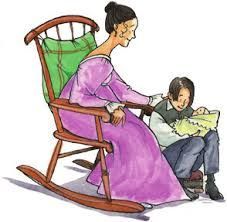
At Home
Chapter 8
Karen Donnelly
Text Illustrated:
We sat round the fire, and talked delightfully. I told them what a hard master Mr. Creakle was, and they pitied me very much. I told them what a fine fellow Steerforth was, and what a patron of mine, and Peggotty said she would walk a score of miles to see him. I took the little baby in my arms when it was awake, and nursed it lovingly. When it was asleep again, I crept close to my mother’s side according to my old custom, broken now a long time, and sat with my arms embracing her waist, and my little red cheek on her shoulder, and once more felt her beautiful hair drooping over me—like an angel’s wing as I used to think, I recollect—and was very happy indeed.
Henry Fothergill Chorley
16 HYDE PARK GATE SOUTH,
KENSINGTON GORE. W.
Sunday Ninth March 1862
My Dear Chorley,
Are you coming to me on Thursday. It is Copperfield on that day week also. I mention this, in case you should have other fish to fry on Thursday first.
Ever affecy.
CD.
16 HYDE PARK GATE SOUTH,
KENSINGTON GORE. W.
Sunday Ninth March 1862
My Dear Chorley,
Are you coming to me on Thursday. It is Copperfield on that day week also. I mention this, in case you should have other fish to fry on Thursday first.
Ever affecy.
CD.
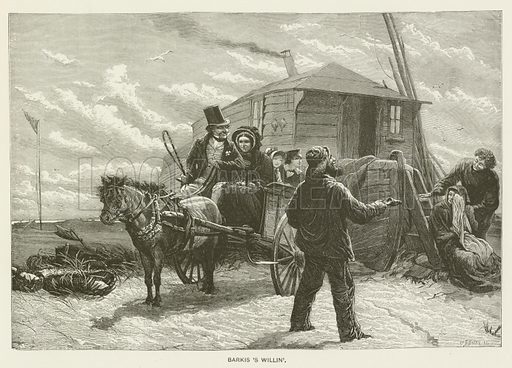
Barkis is willing
Chapter 10
Charles Staniland
Text Illustrated:
Peggotty was dressed as usual, in her neat and quiet mourning; but Mr. Barkis bloomed in a new blue coat, of which the tailor had given him such good measure, that the cuffs would have rendered gloves unnecessary in the coldest weather, while the collar was so high that it pushed his hair up on end on the top of his head. His bright buttons, too, were of the largest size. Rendered complete by drab pantaloons and a buff waistcoat, I thought Mr. Barkis a phenomenon of respectability.
When we were all in a bustle outside the door, I found that Mr. Peggotty was prepared with an old shoe, which was to be thrown after us for luck, and which he offered to Mrs. Gummidge for that purpose.
‘No. It had better be done by somebody else, Dan’l,’ said Mrs. Gummidge. ‘I’m a lone lorn creetur’ myself, and everythink that reminds me of creetur’s that ain’t lone and lorn, goes contrary with me.’
‘Come, old gal!’ cried Mr. Peggotty. ‘Take and heave it.’
‘No, Dan’l,’ returned Mrs. Gummidge, whimpering and shaking her head. ‘If I felt less, I could do more. You don’t feel like me, Dan’l; thinks don’t go contrary with you, nor you with them; you had better do it yourself.’
But here Peggotty, who had been going about from one to another in a hurried way, kissing everybody, called out from the cart, in which we all were by this time (Em’ly and I on two little chairs, side by side), that Mrs. Gummidge must do it. So Mrs. Gummidge did it; and, I am sorry to relate, cast a damp upon the festive character of our departure, by immediately bursting into tears, and sinking subdued into the arms of Ham, with the declaration that she knowed she was a burden, and had better be carried to the House at once. Which I really thought was a sensible idea, that Ham might have acted on.
Kim
What a smorgasbord of illustrations. I just can’t warm up to any of them. That said, I always look forward to the Kyd ones. They are, well, unique. Has there ever been one of a female that looks like a female?
What a smorgasbord of illustrations. I just can’t warm up to any of them. That said, I always look forward to the Kyd ones. They are, well, unique. Has there ever been one of a female that looks like a female?
Kim wrote: "Tristram wrote: "When my colleague retired from work, he lived but for one year or so and then he died. I wouldn't need two guesses at the real cause of his death."
So do you ever see his wife any..."
I never see his wife any more and we are both the happier for it.
So do you ever see his wife any..."
I never see his wife any more and we are both the happier for it.
Kim wrote: "Tristram wrote: "Did "lower class" figures have to be slightly amusing in order to be palatable to readers?"
I once read, I can't remember where, that most of Dickens readers were the lower class...."
Unluckily, it will be difficult to find written testimony as to what Dickens's lower class readers thought of his portrayal of their class as I doubt they will have put down their thoughts in writing.
I once read, I can't remember where, that most of Dickens readers were the lower class...."
Unluckily, it will be difficult to find written testimony as to what Dickens's lower class readers thought of his portrayal of their class as I doubt they will have put down their thoughts in writing.
Kim wrote: "Tristram wrote: "As to Hard Times, which happens to be my least favourite Dickens novel but one, "
What's the one? Hard Times happens to be my least favorite but none."
What's the one? Can't you guess ;-)
What's the one? Hard Times happens to be my least favorite but none."
What's the one? Can't you guess ;-)
 Kim wrote: "Catherine was so shocked by the death of her younger sister that she suffered a miscarriage a few days later...."
Kim wrote: "Catherine was so shocked by the death of her younger sister that she suffered a miscarriage a few days later...."I don't remember ever hearing that Catherine had a miscarriage following Mary's death. How very sad. Poor Catherine -- I wish she and I had been neighbors and could have chatted over tea from time to time. I would love to know what she thought of her husband's grief over her sister's death. And don't you wish you knew what Mary's last words were?! Did Dickens grieve for his dead baby at all? So many questions. The whole thing is so twisted.
 Re: Kyd's illustrations --
Re: Kyd's illustrations --I have a Players cigarette card that has yet another version of Murdstone. Similar, but a different pose.
Interesting that Tristram thinks Kyd got Peggotty right. I was thinking she wasn't portrayed as nearly stout enough to burst her buttons.
In doing a Google image search of Kyd's Dickens illustrations, the most feminine face I saw was of our hero, David Copperfield. Hmm... Second would be Little Nell, but I think that's more to do with her clothing than her countenance.
Mary Lou wrote: "Interesting that Tristram thinks Kyd got Peggotty right. I was thinking she wasn't portrayed as nearly stout enough to burst her buttons."
Yes, she's deficient in stoutness ;-) but her face isn't that bad, for Kyd's standards, and the whole figure exudes an air of rough and ready friendliness.
Yes, she's deficient in stoutness ;-) but her face isn't that bad, for Kyd's standards, and the whole figure exudes an air of rough and ready friendliness.
Mary Lou wrote: "Re: Kyd's illustrations --
I have a Players cigarette card that has yet another version of Murdstone. Similar, but a different pose.
Interesting that Tristram thinks Kyd got Peggotty right. I wa..."
That just gave me an idea of putting all my Kyd illustrations in one thread someday. I have to think about it for awhile.
I have a Players cigarette card that has yet another version of Murdstone. Similar, but a different pose.
Interesting that Tristram thinks Kyd got Peggotty right. I wa..."
That just gave me an idea of putting all my Kyd illustrations in one thread someday. I have to think about it for awhile.
Tristram wrote: "Yes, she's deficient in stoutness ;-) but her face isn't that bad..."
I thought the same thing about the face, it seems like the best one I've ever seen for a woman, I'm not sure it looks like Peggotty to me, more like how I picture Clara. But the face isn't bad.
I thought the same thing about the face, it seems like the best one I've ever seen for a woman, I'm not sure it looks like Peggotty to me, more like how I picture Clara. But the face isn't bad.
Mary Lou wrote: "Kim wrote: "I don't remember ever hearing that Catherine had a miscarriage followi..."
I didn't remember that either, I'll have to look for more info.
I didn't remember that either, I'll have to look for more info.
Bobbie wrote: "In this section, I was most moved by the report from Peggotty regarding the behavior and feelings of Clara during the time that David was absent from her. It shows how genuine her feelings were for..."
I was also moved by Peggotty's telling of Clara's death, almost like Clara had been her daughter and she was more than a servant.
I was also moved by Peggotty's telling of Clara's death, almost like Clara had been her daughter and she was more than a servant.
Mary Lou wrote: "And speaking of Traddles, I quite like the anonymous illustration (message 29 - does it say "Williams" vertically, in the lower-left corner?)."
Yes, it does say Williams but I haven't figured out who he or she is yet.
Yes, it does say Williams but I haven't figured out who he or she is yet.
Here's something I found about Basil Rathbone, who played Murdstone in 1935:
Basil Rathbone was an English actor. He rose to prominence in the United Kingdom as a Shakespearean stage actor and went on to appear in more than 70 films, primarily costume dramas, swashbucklers and, occasionally, horror films.
Rathbone frequently portrayed suave villains or morally ambiguous characters, such as Mr. Murdstone in David Copperfield (1935) and Sir Guy of Gisbourne in The Adventures of Robin Hood (1938). His most famous role was that of Sherlock Holmes in fourteen Hollywood films made between 1939 and 1946 and in a radio series. His later career included roles on Broadway, as well as self-ironic film and television work. He received a Tony Award in 1948 as Best Actor in a Play. He was also nominated for two Academy Awards and was honoured with three stars on the Hollywood Walk of Fame.
In 1935 [Rathbone's] full fury as a villain was unleashed in 'David Copperfield.' As written by Charles Dickens—and played by Basil Rathbone—Mr. Murdstone was one of the most vile, despicable characters in modern fiction. His delight in beating the young Copperfield was vividly captured in Rathbone's performance. The film's beating sequence had to be shot several times because Rathbone was so unnerved by what he was required to do.
Murdstone is the blackest villain Rathbone ever played, and he practically leaps off the screen in a way he never had before. Rathbone said:
“I do not like to play the often quite despicable characters I do. To be convincing, I have to summon up such unpleasant thoughts and feelings. I am frequently worn out and discouraged after a day with them at the studio".
Basil Rathbone could send shivers down the spine. When he cast his evil eyes on David Copperfield, intent on lashing the child with a whip, his face became a mask of cruelty. His character's name, Mr. Murdstone, (a hint of murder with a heart of stone) told the audience all they needed to know about him. ... He had played so many villains on stage by this time that you would think he should have been undaunted by the prospect of playing the merciless Mr. Murdstone in David Copperfield (1935) for MGM. ... Rathbone's Mr. Murdstone is still chilling to watch, but he once admitted that his big scene made him sick to his stomach after several retakes were required to satisfy George Cukor's quest for realism. Everyone connected with the project received high praise.
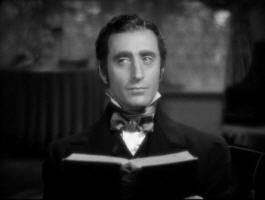
Murdstone hears David making a mistake in his lessons.
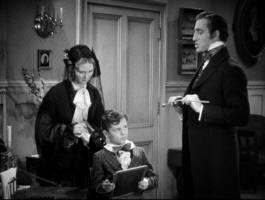
Murdstone questions David further.
Basil Rathbone was an English actor. He rose to prominence in the United Kingdom as a Shakespearean stage actor and went on to appear in more than 70 films, primarily costume dramas, swashbucklers and, occasionally, horror films.
Rathbone frequently portrayed suave villains or morally ambiguous characters, such as Mr. Murdstone in David Copperfield (1935) and Sir Guy of Gisbourne in The Adventures of Robin Hood (1938). His most famous role was that of Sherlock Holmes in fourteen Hollywood films made between 1939 and 1946 and in a radio series. His later career included roles on Broadway, as well as self-ironic film and television work. He received a Tony Award in 1948 as Best Actor in a Play. He was also nominated for two Academy Awards and was honoured with three stars on the Hollywood Walk of Fame.
In 1935 [Rathbone's] full fury as a villain was unleashed in 'David Copperfield.' As written by Charles Dickens—and played by Basil Rathbone—Mr. Murdstone was one of the most vile, despicable characters in modern fiction. His delight in beating the young Copperfield was vividly captured in Rathbone's performance. The film's beating sequence had to be shot several times because Rathbone was so unnerved by what he was required to do.
Murdstone is the blackest villain Rathbone ever played, and he practically leaps off the screen in a way he never had before. Rathbone said:
“I do not like to play the often quite despicable characters I do. To be convincing, I have to summon up such unpleasant thoughts and feelings. I am frequently worn out and discouraged after a day with them at the studio".
Basil Rathbone could send shivers down the spine. When he cast his evil eyes on David Copperfield, intent on lashing the child with a whip, his face became a mask of cruelty. His character's name, Mr. Murdstone, (a hint of murder with a heart of stone) told the audience all they needed to know about him. ... He had played so many villains on stage by this time that you would think he should have been undaunted by the prospect of playing the merciless Mr. Murdstone in David Copperfield (1935) for MGM. ... Rathbone's Mr. Murdstone is still chilling to watch, but he once admitted that his big scene made him sick to his stomach after several retakes were required to satisfy George Cukor's quest for realism. Everyone connected with the project received high praise.

Murdstone hears David making a mistake in his lessons.

Murdstone questions David further.
 Oh, thank you for these! The Court Jester is one of my favorite movies and Rathbone is the villain in that one too--though he is kind of playing a parody of all his other villains. I can definitely imagine him as Murdstone.
Oh, thank you for these! The Court Jester is one of my favorite movies and Rathbone is the villain in that one too--though he is kind of playing a parody of all his other villains. I can definitely imagine him as Murdstone.
Kim wrote: "Is he the best Murdstone?
https://www.youtube.com/watch?v=T-2dV..."
That was a chilling and disturbing scene.
https://www.youtube.com/watch?v=T-2dV..."
That was a chilling and disturbing scene.
Peter wrote: "What I do see as an essential element to the illustration is the presence of a clock. As David is portrayed entering the room he becomes aware that his role as a child has shifted. His mother .."
Clocks, food, and of course birds, how do you keep track of it all? :-)
Clocks, food, and of course birds, how do you keep track of it all? :-)
Peter wrote: ".What is important and I think telling is how food plays a role in identifying good and bad characters. Peggotty gives David “some paper bags of cakes” as he ventures off to Salem School. Mrs Mell ."
More food, Mr. Peggotty and Ham bring food when they visit David at the school:
There was a silence. Mr. Peggotty, to relieve it, took two prodigious lobsters, and an enormous crab, and a large canvas bag of shrimps, out of his pockets, and piled them up in Ham’s arms.
‘You see,’ said Mr. Peggotty, ‘knowing as you was partial to a little relish with your wittles when you was along with us, we took the liberty. The old Mawther biled ‘em, she did. Mrs. Gummidge biled ‘em. Yes,’ said Mr. Peggotty, slowly, who I thought appeared to stick to the subject on account of having no other subject ready, ‘Mrs. Gummidge, I do assure you, she biled ‘em.’
More food, Mr. Peggotty and Ham bring food when they visit David at the school:
There was a silence. Mr. Peggotty, to relieve it, took two prodigious lobsters, and an enormous crab, and a large canvas bag of shrimps, out of his pockets, and piled them up in Ham’s arms.
‘You see,’ said Mr. Peggotty, ‘knowing as you was partial to a little relish with your wittles when you was along with us, we took the liberty. The old Mawther biled ‘em, she did. Mrs. Gummidge biled ‘em. Yes,’ said Mr. Peggotty, slowly, who I thought appeared to stick to the subject on account of having no other subject ready, ‘Mrs. Gummidge, I do assure you, she biled ‘em.’
Peter wrote: "Kim wrote: "Is he the best Murdstone?
https://www.youtube.com/watch?v=T-2dV..."
That was a chilling and disturbing scene."
I guess it's not surprising the actor had trouble acting in that scene.
https://www.youtube.com/watch?v=T-2dV..."
That was a chilling and disturbing scene."
I guess it's not surprising the actor had trouble acting in that scene.
Kim wrote: "Tristram wrote: "Yes, she's deficient in stoutness ;-) but her face isn't that bad..."
I thought the same thing about the face, it seems like the best one I've ever seen for a woman, I'm not sure ..."
Yes, when it comes to Kyd, you are satisfied with little things already. ;-)
I thought the same thing about the face, it seems like the best one I've ever seen for a woman, I'm not sure ..."
Yes, when it comes to Kyd, you are satisfied with little things already. ;-)
I don't know all the actors who ever played Murdstone but would surely rank Rathbone among the best. He was a brilliant actor anyway and strongly shaped people's idea of Sherlock Holmes, even though the movies were not among the best. Saying that, I might just as well add that for me Jeremy Brett is the perfect impersonator of Holmes. When it comes to Miss Murdstone, I think I should have preferred Judith Anderson in that role.
I don't know these people. At least not by just reading their names:
Being one of the central antagonists of the novel, Murdstone has appeared in every adaptation of David Copperfield to date.
In the 1935 film version, he is portrayed by Basil Rathbone.

Basil Rathbone
In the 1969 version, he is played by James Donald. In this version, Murdstone does not bother to search for David after he leaves for Dover, thus his argument with Betsey Trotwood is omitted.
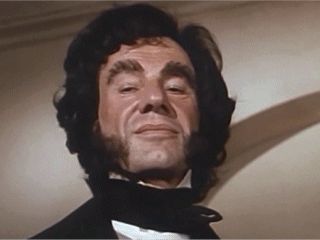
James Donald
In the 1974 BBC TV series he is played by Gareth Thomas.

Gareth Thomas
In the 1986 BBC TV series he is played by Oliver Cotton.

Oliver Cotton
In the 1993 version, Michael York.is the voice of Murdstone, the film is animated.
In the 1999 BBC mini-series, Murdstone is portrayed by Trevor Eve. In this version, his role plays out fairly closely to the novel, only he does not appear again after his scolding by Betsy Trotwood (Maggie Smith).

Trevor Eve
In the 2000 British-American television film, he is portrayed by Anthony Andrews, who had played Steerforth in the 1974 BBC TV series. Murdstone appears much later in the film, where David is an adult and catches him dining with Jane and another young woman. David furiously confronts Murdstone and openly accuses him of murdering his mother. Murdstone denies it and challenges David to prove it in court, but David instead promises to write about it and destroy Murdstone's image once and for all, avenging his mother and ensuring that the Murdstones will never snatch away another family fortune again.
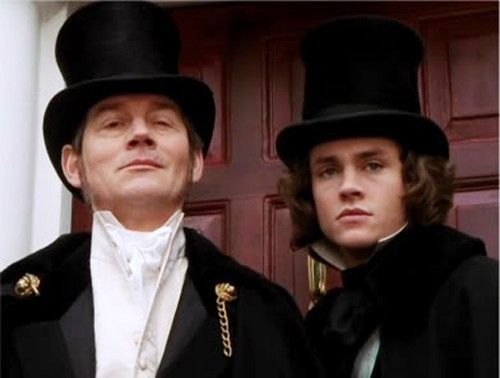
Anthony Andrews
Being one of the central antagonists of the novel, Murdstone has appeared in every adaptation of David Copperfield to date.
In the 1935 film version, he is portrayed by Basil Rathbone.

Basil Rathbone
In the 1969 version, he is played by James Donald. In this version, Murdstone does not bother to search for David after he leaves for Dover, thus his argument with Betsey Trotwood is omitted.

James Donald
In the 1974 BBC TV series he is played by Gareth Thomas.

Gareth Thomas
In the 1986 BBC TV series he is played by Oliver Cotton.

Oliver Cotton
In the 1993 version, Michael York.is the voice of Murdstone, the film is animated.
In the 1999 BBC mini-series, Murdstone is portrayed by Trevor Eve. In this version, his role plays out fairly closely to the novel, only he does not appear again after his scolding by Betsy Trotwood (Maggie Smith).

Trevor Eve
In the 2000 British-American television film, he is portrayed by Anthony Andrews, who had played Steerforth in the 1974 BBC TV series. Murdstone appears much later in the film, where David is an adult and catches him dining with Jane and another young woman. David furiously confronts Murdstone and openly accuses him of murdering his mother. Murdstone denies it and challenges David to prove it in court, but David instead promises to write about it and destroy Murdstone's image once and for all, avenging his mother and ensuring that the Murdstones will never snatch away another family fortune again.

Anthony Andrews
Julie wrote: "Oh, thank you for these! The Court Jester is one of my favorite movies and Rathbone is the villain in that one too--though he is kind of playing a parody of all his other villains. I can definitely..."
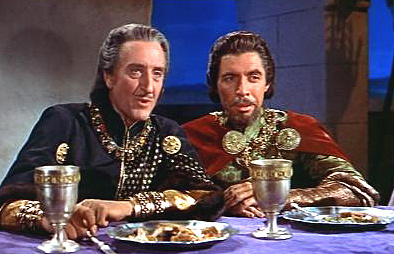
The Court Jester
As the conniving Lord Ravenhurst, Rathbone does a hilarious spoof of his swashbuckling villains. A supercilious smarty pants who is taken in by jester Danny Kaye, he is a brilliant cog in this brilliant film. His ability to play comedy with a sneer is equal to his ability to play evil with deadly seriousness. After much maneuvering with poisons ("the pellet with the poison's in the vessel with the pestle; the chalice from the palace has the brew that is true!") and knighthoods, his Lord Ravenhurst is literally expelled from the castle by a catapult. He was nasty, but he was so much fun!

The Court Jester
As the conniving Lord Ravenhurst, Rathbone does a hilarious spoof of his swashbuckling villains. A supercilious smarty pants who is taken in by jester Danny Kaye, he is a brilliant cog in this brilliant film. His ability to play comedy with a sneer is equal to his ability to play evil with deadly seriousness. After much maneuvering with poisons ("the pellet with the poison's in the vessel with the pestle; the chalice from the palace has the brew that is true!") and knighthoods, his Lord Ravenhurst is literally expelled from the castle by a catapult. He was nasty, but he was so much fun!
Kim, of all the Murdstones you found, I think that Gareth Thomas comes closest to the man's looks as I imagine them. Still, it's hard to out-villain Basil Rathbone ;-)
I somehow imagined him as Basil Rathbone the most. After all, he had to be handsome enough that Clara fell in love with him somehow, and I don't see Gareth Thomas (at least in that picture) as sleek enough to fit the bill.
Jantine wrote: "I somehow imagined him as Basil Rathbone the most. After all, he had to be handsome enough that Clara fell in love with him somehow, and I don't see Gareth Thomas (at least in that picture) as slee..."
He's my choice too. Of course he's the only one I saw in a video maybe that makes a difference.
He's my choice too. Of course he's the only one I saw in a video maybe that makes a difference.
 Kim wrote: "Is he the best Murdstone?
Kim wrote: "Is he the best Murdstone?https://www.youtube.com/watch?v=T-2dV..."
I'm less disturbed by the movie clip than I am by the ad in the corner which reads, "Into spanking? w...w.SpankYourDate.c...m".
Oh, my...
 I like Rathbone, too, but thought Anthony Andrews might do well, so I looked him up. Here's his full movie on youtube, with the caning scene starting around 33:20.
I like Rathbone, too, but thought Anthony Andrews might do well, so I looked him up. Here's his full movie on youtube, with the caning scene starting around 33:20. https://www.youtube.com/watch?v=IZI6Q...
My take? The first David is better; Andrews is okay, but not as good as Rathbone; Clara and Jane are better in the newer version. If I'm not mistaken, Jane is played by Doc Martin's aunt (I don't know the name of the actress). I wanted to see how Peggotty was cast, so I skipped forward a bit. She's played by the actress who played Daisy on Keeping Up Appearances, and is very much how I picture Peggotty. When we're done with the book, I think I'll come back and watch this one.
 Oh, my gosh! I skipped forward again to see how the casting was for Mr. Micawber, and he's played by Michael Richards, aka Kramer on Seinfeld! I won't be able to read any upcoming scenes Micawber might be in without picturing Richards. He plays the two roles somewhat similarly, and I'm surprised to say that it seems to work. Though I think I'd enjoy his Micawber more if I'd never seen Kramer.
Oh, my gosh! I skipped forward again to see how the casting was for Mr. Micawber, and he's played by Michael Richards, aka Kramer on Seinfeld! I won't be able to read any upcoming scenes Micawber might be in without picturing Richards. He plays the two roles somewhat similarly, and I'm surprised to say that it seems to work. Though I think I'd enjoy his Micawber more if I'd never seen Kramer.




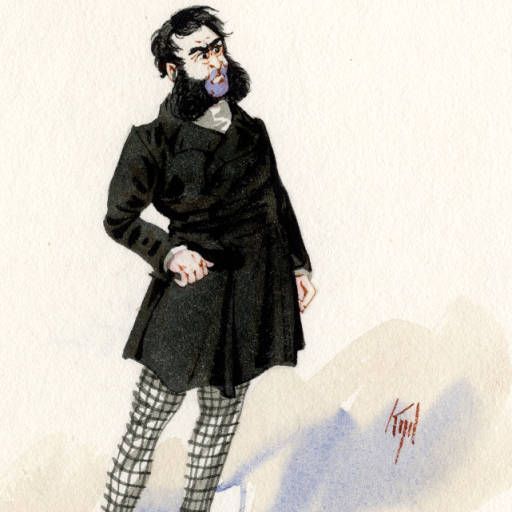
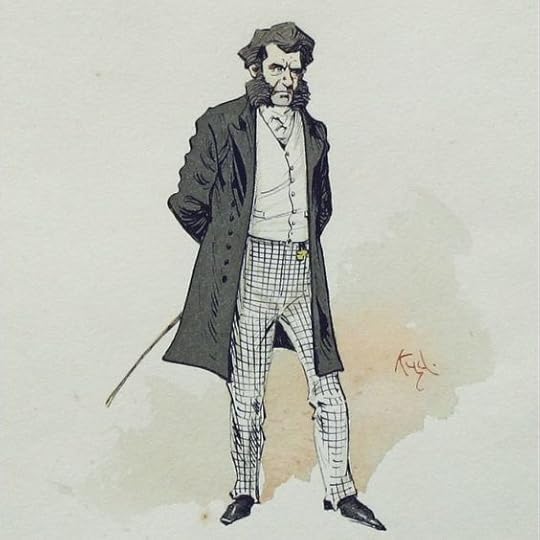
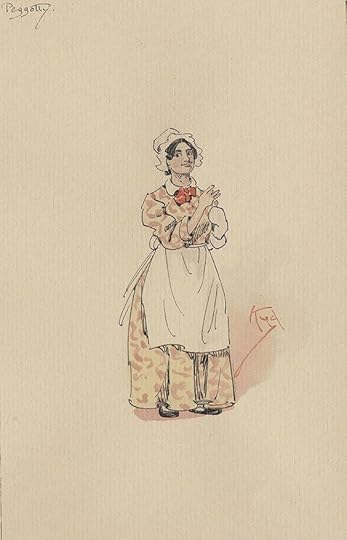
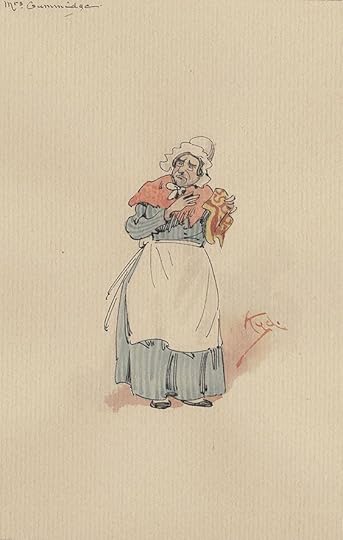

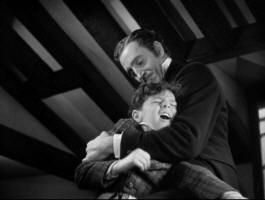
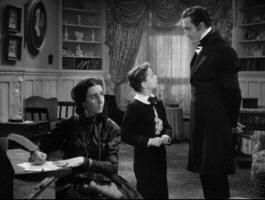
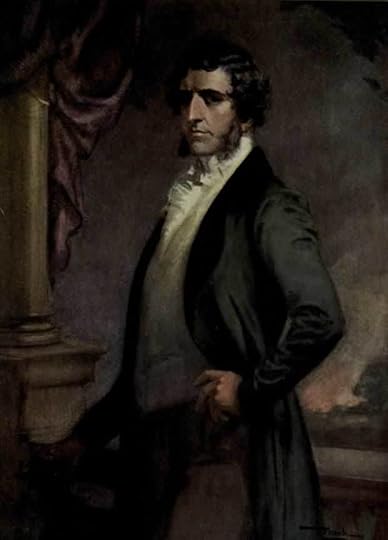


This is true, and also they are often the worthiest characters in the book--compare Clara Copperfield and Clara Peggotty so far, for instance; and also it's obvious that the Peggotty boat is a better place to live than the Murdstone house. But they also have to be comic or dull enough to be happy where they are--I guess because, as Peter says, ultimately Dickens has no interest in shaking things up socially.
I will be curious to see what this group thinks of Hard Times, in which it's impossible for the lower-class characters to be happy where they are.
I'm now thinking maybe it's uncomfortable when David makes sure Steerforth knows he's a gentleman and the Peggottys are his inferiors not because Dickens doesn't think they're David's inferiors, but because it displays David's insecurity. If David were a better or more confident person, he wouldn't find it necessary to emphasize his status as a gentleman's son.